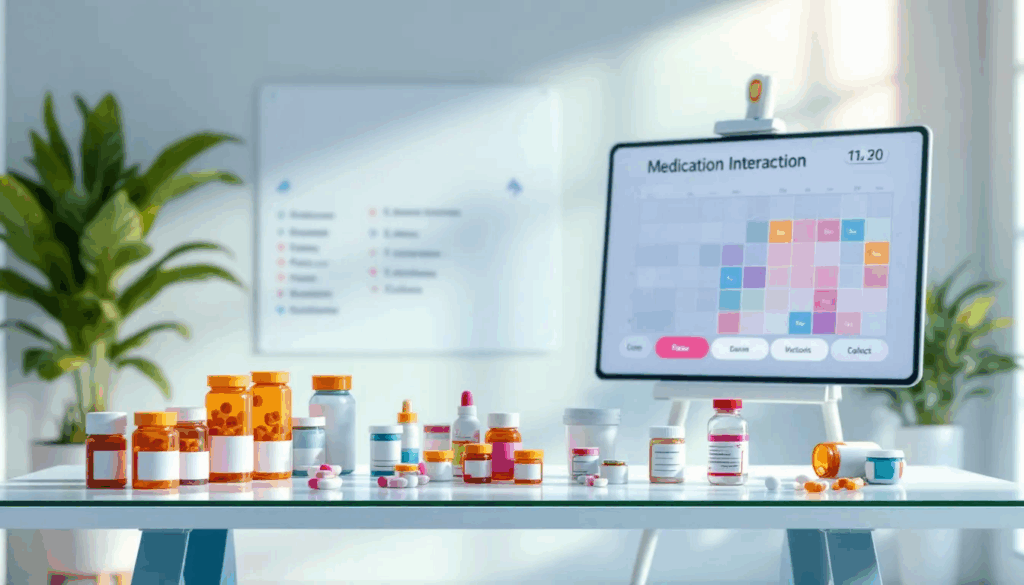When taking low dose naltrexone (LDN), avoiding certain substances and conditions is crucial for your safety and the treatment’s success. Key areas of concern include interactions with opioids, alcohol, and specific medications. This guide will help you understand what to avoid when taking low dose naltrexone to ensure the best outcomes.
Key Takeaways
- Patients taking low dose naltrexone must avoid opioids to prevent severe withdrawal symptoms and treatment ineffectiveness.
- Abstaining from alcohol and recreational drugs is essential, as these can hinder treatment efficacy and pose significant health risks.
- Regular consultations with healthcare providers are critical for monitoring treatment progress, managing side effects, and customizing dosages for optimal outcomes.
Avoiding Opioids

Taking low dose naltrexone necessitates the strict avoidance of opioids, as their concurrent use may result in significant problems such as opioid withdrawal symptoms and diminished treatment success. Naltrexone blocks the effects of opioids by occupying opioid receptors, which can trigger withdrawal symptoms even with lower doses of opioids involved. This not only thwarts attempts at pain relief, but also intensifies discomfort, complicating the journey toward recovery.
It’s imperative to abstain from all opioid medications while undergoing therapy with LDN to guarantee favorable treatment outcomes and maintain stability. Since opioid dependence can greatly undermine the effectiveness of LDN therapy, steering clear of any opioid analgesics or other conflicting drugs is essential for successful management.
Opioid Withdrawal Symptoms
Opioid withdrawal symptoms can be a harrowing ordeal, marked by various physical and psychological effects. Common symptoms consist of:
- nausea
- vomiting
- diarrhea
- lack of appetite
- hot and cold flushes
- anxiety
- irritation
- runny nose
- watery eyes
- sweating
When low dose naltrexone is introduced into the system, it blocks opioid receptors, which can trigger these withdrawal symptoms if opioids are still present.
Waiting 10 to 14 days after the last dose of opioids before starting LDN therapy can mitigate these risks. This waiting period helps to clear opioid medications like morphine or hydrocodone from the system, reducing the likelihood of withdrawal symptoms and allowing naltrexone to work effectively without interference.
Informing Healthcare Providers
When initiating low dose naltrexone therapy, it is crucial to maintain open communication with your healthcare provider. Revealing any recent opioid consumption to them is essential for averting withdrawal symptoms and maximizing the effectiveness of LDN treatment. Concealing this information could result in negative consequences, including the onset of withdrawal symptoms or diminished success of the treatment.
Before commencing LDN treatment, healthcare providers might carry out specific assessments such as the naloxone challenge test to verify an absence of opioids in your system. This step allows for a personalized approach to your therapeutic regimen by establishing a safe and beneficial dose of naltrexone that reduces adverse reactions while enhancing recovery outcomes.
Alcohol Consumption and Low Dose Naltrexone

Utilizing low dose naltrexone can be highly effective for individuals dealing with chronic pain or opioid use disorder. Its effectiveness is substantially diminished if alcohol is consumed. Those recovering from alcohol dependence might find that naltrexone aids in maintaining sobriety. Yet the ingestion of alcoholic beverages during a low dose naltrexone regimen could cause serious damage to the liver and impair the treatment’s success. It’s critically important—and advised—that one completely avoids drinking while following this therapy.
Indulging in alcohol while on LDN may compromise your ability to accurately gauge how drunk you are, posing potential risks to safety. To facilitate an uninterrupted and successful recovery journey via naltrexone therapy, it is imperative to steer clear of any alcohol consumption entirely.
Liver Health
It’s essential to preserve liver health while undergoing low dose naltrexone therapy. Ingestion of alcohol during LDN treatment may intensify any adverse effects related to the liver, hence it is critical to completely refrain from drinking alcohol. This is especially crucial for individuals who already suffer from liver issues since mixing alcohol with their condition could lead to more severe hepatic problems.
By steering clear of alcoholic beverages, you assist your liver in efficiently metabolizing drugs, which helps maintain the safety and efficacy of your low dose naltrexone regimen. Adhering to this straightforward but important precaution can greatly improve both your general well-being and the success rate of your treatment.
Impaired Functioning
Consuming alcohol may undermine the efficacy of low dose naltrexone therapy, resulting in diminished coordination and decision-making abilities without the sensation of intoxication. Such impairment is especially hazardous for those dealing with chronic illnesses or mental health disorders that require meticulous functioning.
Combining alcohol with low dose naltrexone can amplify dangers, obstructing your path to recovery and possibly causing detrimental reactions. For optimal results from your naltrexone treatment, it’s imperative to completely refrain from drinking alcohol.
Drug Interactions to Watch For

It is crucial to be mindful of the risk of drug interactions while on a low dose naltrexone regimen, as these can affect the safety and efficacy of your treatment. It’s important to share information about all current medications with healthcare providers to effectively monitor for potential drug interactions and uphold treatment integrity. Drugs that are metabolized by the same liver enzymes may interfere with LDN and provoke negative side effects.
When using low dose naltrexone, adverse reactions could occur if combined with narcotic painkillers, certain cough suppressants, or antidiarrheal drugs. Before taking any over-the-counter medicines, dietary supplements or herbal preparations alongside LDN therapy, it’s imperative you discuss this with your healthcare provider due to their ability to potentially interact with low dose naltrexone.
Over-the-Counter Medications
It is important to be careful when taking over-the-counter medications in conjunction with low dose naltrexone (LDN) to prevent adverse reactions. For example, care should be taken with the use of dextromethorphan, commonly found in cough remedies, as it may interact with LDN and negate its potential therapeutic benefits.
When undergoing LDN treatment, always proceed with caution regarding any over-the-counter drugs. Before introducing any new medication that does not require a prescription into your regimen, make sure to seek advice from your healthcare provider to maintain a safe and effective course of treatment.
Prescription Medications
When undergoing low dose naltrexone therapy, it is essential to steer clear of prescription medications that contain opioid-based pain relievers such as oxycodone or hydrocodone. The reason for this precaution is the risk of negative reactions stemming from LDN’s role as an opioid antagonist, which can negate the effects of these drugs.
Before taking any other medication alongside low dose naltrexone, including those prescribed for coughs, colds, or diarrhea relief, it’s imperative to seek advice from a healthcare professional. Doing so allows you to obtain recommendations for alternative treatments that do not include opioids and ensures that your use of low dose naltrexone remains safe and effective without undesirable drug interactions.
Herbal Supplements
Taking low dose naltrexone can lead to negative interactions if combined with certain herbal supplements. For instance, avoid using Kratom as it has compounds similar to opioids that could interfere with the effects of LDN. Similarly, St. John’swort should be used cautiously since it may affect metabolic pathways shared by low dose naltrexone.
Before initiating or discontinuing any herbal supplements while on a regimen of low dose naltrexone, make sure to discuss it with your healthcare provider. Doing so will help maintain the integrity and safety of your treatment plan by reducing the likelihood of potential drug interactions.
Special Medical Considerations

When considering the use of low dose naltrexone, it is essential to engage in a thorough conversation with your healthcare provider about your medical background. This step ensures that you receive personalized care while minimizing potential negative reactions. Make sure to cover any medications you are currently using and address how they might interact with LDN.
Those living with kidney or liver disease, as well as individuals suffering from autoimmune disorders, should be closely observed for their response to low dose naltrexone therapy and may require adjustments in dosage. It’s important to keep your healthcare provider informed about all certain medications you’re taking so as not to inadvertently introduce opioids into your system or exacerbate pre-existing kidney and liver issues.
Liver Disease
People with liver disease must be closely observed while on low dose naltrexone to identify possible liver complications promptly. It’s important to regularly check liver function so that any negative reactions can be quickly identified and the dosage of naltrexone adjusted if necessary.
Before beginning treatment with low dose naltrexone, it is critical for individuals with liver disease to seek advice from a healthcare provider. This step helps guarantee the safe and effective management of their condition by ensuring early detection and intervention for any adverse effects linked to the liver.
Kidney Disease
Patients suffering from kidney disease must be closely monitored when taking low dose naltrexone, as their renal function can influence the way medications are metabolized. To guarantee that treatment with low dose naltrexone is both safe and effective, dosage modifications might be required. Consistent check-ups are vital to identify any arising problems promptly and modify the therapy plan as needed.
It is essential for individuals living with chronic conditions such as kidney disease to seek advice from healthcare providers before initiating treatment with LDN. Engaging in this dialogue allows for a customized treatment strategy tailored to meet individual requirements, facilitating a therapeutic process that is both secure and beneficial.
Autoimmune Disorders
Individuals suffering from autoimmune disorders such as multiple sclerosis, Crohn’s disease, or fibromyalgia chronic fatigue syndrome must consistently re-evaluate their treatment strategies with their healthcare providers to guarantee both safety and effectiveness. Since low dose naltrexone may have interactions with other therapies for autoimmune diseases, it is crucial to maintain a well-integrated and managed care plan.
Pregnancy and Breastfeeding
Administering low dose naltrexone during pregnancy and while breastfeeding necessitates meticulous deliberation. The FDA has assigned it a Category C classification, indicating that although there is no conclusive evidence of harm, the inability to completely dismiss potential risks underscores the importance of consulting with healthcare providers. They will assist in evaluating whether the benefits justify these possible risks.
Individuals who are trying to become pregnant or are currently pregnant must engage in conversation with their healthcare provider about how low dose naltrexone may affect reproductive health. Such dialogue is crucial for ensuring the protection of both mother and child without overlooking the medicinal advantages that low dose naltrexone might offer.
Potential Risks
There isn’t concrete proof that low dose naltrexone leads to congenital anomalies, but it is classified as FDA Pregnancy Category C. This classification suggests that we can’t completely dismiss the possibility of risk. While the medication appears safe when passed through breast milk, the scarcity of comprehensive research calls for a careful approach.
Healthcare providers are equipped to offer advice on the possible hazards and advantages associated with using low dose naltrexone during pregnancy and while nursing. Such discussions guarantee decisions are made with ample knowledge, taking into account the well-being of both mother and baby.
Missed Doses
Should you forget to take a dose of low-dose naltrexone, adhere to the following guidelines:
- Administer the missed dose immediately upon recollection, unless it is almost time for your subsequent dose.
- Omit the forgotten dose if your next scheduled dose is approaching soon.
- Proceed as usual with taking your next planned dose.
Employing this strategy ensures that treatment remains steady and avoids any potential adverse effects from overdosing which would not be in accordance with the prescribed dosage.
For individuals who are pregnant or nursing, sticking to a regular dosing schedule is crucial for preserving both safety and effectiveness of treatment. Addressing skipped doses without delay assists in maintaining continuity of low-dose naltrexone’s therapeutic advantages.
Regular Medical Check-Ups
Consistent monitoring by medical personnel is crucial to evaluate the effectiveness of low dose naltrexone therapy and confirm its beneficial impact. Continual collaboration with healthcare professionals ensures that dosage adjustments are personalized according to each individual’s progress and reaction to treatment, ensuring a secure and efficacious therapeutic experience.
Regular meetings enable the prompt detection and handling of any issues related to naltrexone therapy, such as adverse reactions. Maintaining close communication with healthcare providers empowers patients to proceed through their treatment journey with assurance and assistance.
Monitoring Treatment Success
It’s essential to regularly meet with medical professionals to evaluate the success of low dose naltrexone therapy. These appointments are necessary for detecting any new issues and fine-tuning the treatment strategy to enhance its effectiveness. Effective management of potential side effects, such as intense dreams, sleep disturbances, and digestive discomfort, is facilitated by continuous supervision. A thorough grasp of how low dose naltrexone functions is crucial for improving patient results.
While approximately 61,2% of individuals might encounter adverse effects during their course of treatment with low dose naltrexone, there remains a significant proportion—about 38,8%—who may not experience these setbacks at all. This difference highlights why individualized attention and frequent assessments are imperative in guiding a safe and effective treatment journey that patients typically tolerate well.
Identifying Adverse Reactions
Healthcare providers regularly assess patients undergoing low dose naltrexone therapy to track any potential side effects. This monitoring allows them to address and manage these effects properly, maintaining the safety and efficacy of the treatment for their patients.
Patients should report any abnormal or intense symptoms that arise while taking low dose naltrexone to their healthcare provider without delay. Doing so ensures quick intervention for adverse reactions, safeguarding the patient’s health and preserving the effectiveness of their treatment regimen.
Lifestyle and Dietary Recommendations
Enhancing the therapeutic advantages of low dose naltrexone therapy can be achieved by adopting a health-conscious lifestyle. Ensuring adherence to a well-rounded diet and staying adequately hydrated plays a critical role in bolstering one’s general health and optimizing the positive impacts of LDN treatment.
Incorporating routine exercise into daily life, coupled with refraining from alcohol consumption, can significantly amplify the results obtained from addiction treatments. Embracing such beneficial habits aids individuals on their path to recovery and bolsters the efficacy of low dose naltrexone therapy as they progress.
Healthy Diet
Maintaining a varied and healthy diet can play a crucial role in promoting general health as well as amplifying the efficacy of low dose naltrexone therapy. Ensuring your meal plan includes an array of fruits, vegetables, whole grains, and lean proteins is essential to deliver vital nutrients that bolster your body throughout the course of naltrexone treatment.
Ingesting omega-3 fatty acids is beneficial for cognitive processes and might enhance the impact of low dose naltrexone. By steering clear of processed sugars, wheat gluten, and dairy products, you may increase the effectiveness with which LDN operates within your system, thereby allowing you to experience its full potential benefits.
Hydration
Maintaining proper hydration is essential for supporting overall health during low dose naltrexone treatment, as it helps sustain metabolic functions and can reduce potential side effects of LDN. Ensuring the body gets enough water improves its capacity to metabolize medications efficiently, thereby maximizing the benefits of low dose naltrexone therapy.
Recreational Drugs and Low Dose Naltrexone
Engaging in the use of recreational drugs during low dose naltrexone therapy can be extremely risky, potentially leading to intense withdrawal symptoms and an elevated risk of overdose. The interplay between recreational drugs and LDN may prompt individuals to consume higher quantities of opioids in an effort to negate the effects of naltrexone, increasing their chances of overdosing. This practice is particularly dangerous for those with a prior history of substance abuse, as it may disrupt their recovery process and impede therapeutic advancement.
To ensure one’s safety and foster effective treatment outcomes, it is crucial for patients to refrain from using recreational substances while on low dose naltrexone therapy. Steering clear from these materials allows patients to embark on a more secure and efficacious path throughout their treatment journey.
Increased Overdose Risk
Mixing recreational drugs with low dose naltrexone may increase the risk of an opioid overdose. This elevated risk is due to individuals potentially taking greater amounts of opioids in an attempt to overcome the blocking effects that naltrexone has, which could lead to perilous overdose conditions. When using LDN, the body requires larger quantities of opioids for users to feel their expected impact, thus increasing the danger of overdosing.
Steering clear of recreational drugs while undergoing low dose naltrexone therapy reduces these hazards. Taking this measure ensures a more secure therapeutic process and enhances the efficacy of the treatment overall.
Safety Precautions
To guarantee safety during the administration of low dose naltrexone, it is imperative to steer clear of all recreational drugs not prescribed by a physician. Refraining from such substances is essential for preserving health and averting potential risks while on a dose naltrexone regimen. This precautionary measure significantly reduces the likelihood of experiencing intense withdrawal symptoms or an overdose, thus fostering a more secure and successful treatment framework.
It’s important for patients to inform medical personnel that they are taking naltrexone and follow their healthcare professional’s directions precisely when navigating through their recovery journey. Such proactive communication ensures that individuals avoid unintentional opioid use among other pitfalls, contributing to both a safe therapeutic process and effective pain management outcomes.
Summary
Understanding the intricacies of low dose naltrexone therapy is critical for a successful and secure treatment experience. Patients should avoid opioids, alcohol, and recreational drugs while also paying close attention to potential drug interactions to optimize LDN’s therapeutic effects. Regular medical check-ups, maintaining a healthy lifestyle, and transparent communication with healthcare providers will bolster the effectiveness of the treatment.
In summarizing these key guidelines, adherence can greatly enhance the efficacy of low dose naltrexone therapy. With these measures in place, patients are better equipped to confidently progress on their path toward recovery and improve their overall health status.
Frequently Asked Questions
Why is it important to avoid opioids while taking low dose naltrexone?
It is essential to avoid opioids while taking low dose naltrexone, as their combination can cause severe withdrawal symptoms and diminish the effectiveness of the treatment. Naltrexone’s mechanism blocks opioid receptors, which can intensify discomfort and impede pain management efforts.
Can I drink alcohol while on low dose naltrexone?
It is strongly recommended to completely avoid alcohol while taking low dose naltrexone, as it may exacerbate liver-related side effects and diminish the treatment’s effectiveness.
Prioritizing your health during this treatment is essential.
What should I do if I miss a dose of low dose naltrexone?
If you miss a dose of low dose naltrexone, take it as soon as you remember, but skip it if the next dose is almost due.
Do not double the dose to compensate for the missed one to ensure safe and effective treatment.
Are there any over-the-counter medications I should avoid while on low dose naltrexone?
It is advisable to avoid over-the-counter medications containing dextromethorphan while on low dose naltrexone.
Always consult your healthcare provider before using any new medications to prevent potential interactions.
How often should I have medical check-ups while on low dose naltrexone?
You should have regular medical check-ups while on low dose naltrexone to monitor treatment effectiveness, adjust dosages, and identify any potential adverse reactions.
Consistent engagement with your healthcare provider is crucial for safe and effective management of your treatment.
